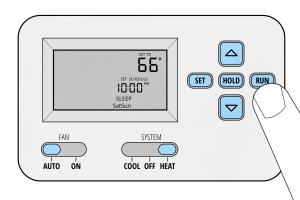Mastering Your Comfort: A Comprehensive Guide on How to Set a Thermostat for Optimal Efficiency

-
Quick Links:
- Introduction
- Types of Thermostats
- Understanding Temperature Settings
- Step-by-Step Guide to Setting Your Thermostat
- Energy Efficiency Tips
- Case Study: The Impact of Proper Thermostat Settings
- Common Mistakes When Setting a Thermostat
- Expert Insights
- FAQs
- Conclusion
Introduction
Setting your thermostat correctly is crucial for maintaining a comfortable home environment while also optimizing energy efficiency. Whether you are using a traditional or a smart thermostat, understanding how to adjust your system can lead to significant savings on your utility bills while ensuring your living space remains cozy. In this guide, we will explore the different types of thermostats, provide a detailed step-by-step setup process, and share tips to enhance your experience.
Types of Thermostats
Before diving into the specifics of setting your thermostat, it's essential to understand the different types available:
- Mechanical Thermostats: These are basic, analog devices that use a bimetallic strip to measure temperature.
- Digital Thermostats: More precise than mechanical options, these provide digital displays and programmable features.
- Smart Thermostats: These devices connect to the internet, allowing remote control through apps and offering learning capabilities to adapt to your habits.
Understanding Temperature Settings
Temperature settings on your thermostat can be categorized into several key areas:
- Heating Mode: Typically set between 68°F and 72°F for comfort during winter months.
- Cooling Mode: Recommended settings range from 75°F to 78°F in the summer to ensure comfort without excessive energy use.
- Energy-Saving Settings: Most modern thermostats allow you to set specific temperatures for periods when you are away from home.
Step-by-Step Guide to Setting Your Thermostat
Follow these steps to set your thermostat effectively:
Step 1: Choose the Right Temperature
Determine your desired comfort level for heating and cooling.
Step 2: Select the Correct Mode
Switch between heating and cooling modes based on the season.
Step 3: Program Your Thermostat
If you have a programmable or smart thermostat, set schedules for when you are home and away.
Step 4: Monitor Your Energy Usage
Use any available features to monitor energy consumption for further optimization.
Step 5: Regularly Update Settings as Needed
Adjust settings according to seasonal changes and personal comfort preferences.
Energy Efficiency Tips
Maximize your thermostat settings with these energy-saving strategies:
- Adjust the thermostat by a few degrees; even a 1°F change can lead to energy savings.
- Utilize ceiling fans to circulate air effectively.
- Seal drafts around windows and doors to maintain temperature.
- Consider investing in a smart thermostat that learns your habits for optimal efficiency.
Case Study: The Impact of Proper Thermostat Settings
A study conducted by the U.S. Department of Energy found that homeowners who properly adjusted their thermostats could save up to 10% on heating and cooling costs annually. For instance, one family in Michigan reduced their annual energy bill by over $300 simply by setting their thermostat to 68°F during winter and 75°F in summer.
Common Mistakes When Setting a Thermostat
Many homeowners make several common errors that can lead to discomfort and increased energy costs:
- Setting the thermostat too low or too high initially, causing the HVAC system to work harder.
- Neglecting to program the thermostat, leading to unnecessary energy use.
- Ignoring the importance of regular maintenance on HVAC systems.
Expert Insights
According to HVAC experts, understanding your HVAC system's capabilities is key to maximizing efficiency. Regular maintenance checks and understanding the settings on your thermostat can significantly enhance your home's comfort level and energy efficiency.
FAQs
1. What is the best temperature to set during winter?
The recommended temperature is between 68°F to 72°F for comfort.
2. How much can I save by adjusting my thermostat?
Adjusting your thermostat can save up to 10% on heating and cooling costs annually.
3. What is the difference between programmable and smart thermostats?
Programmable thermostats allow you to set schedules, while smart thermostats learn your habits and adjust automatically.
4. Should I turn off my thermostat when I am not home?
Yes, it is beneficial to adjust your thermostat while away to save energy.
5. How often should I change the thermostat settings?
Adjust settings seasonally and consider individual comfort preferences.
6. Can I control my smart thermostat remotely?
Yes, most smart thermostats can be controlled via an app on your smartphone.
7. What temperature should I set for cooling during the summer?
A temperature setting between 75°F to 78°F is typically recommended for summer.
8. What if my thermostat is not responding?
Check the power supply, ensure it’s correctly programmed, and replace batteries if necessary.
9. How can I improve my thermostat’s accuracy?
Ensure proper placement away from drafts, direct sunlight, and heat sources.
10. Is it worth investing in a smart thermostat?
Yes, they offer convenience, learning capabilities, and potential energy savings.
Conclusion
Setting your thermostat correctly is not just about comfort; it is also about efficiency and savings. By understanding the types of thermostats, how to set them, and implementing energy-saving strategies, you can significantly improve your home environment. This guide provides you with the knowledge to master your thermostat, ensuring comfort year-round while saving on energy costs.